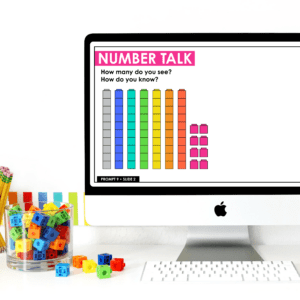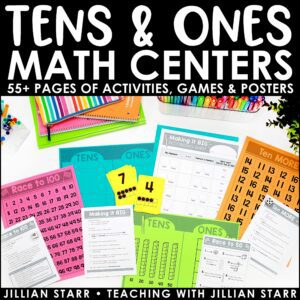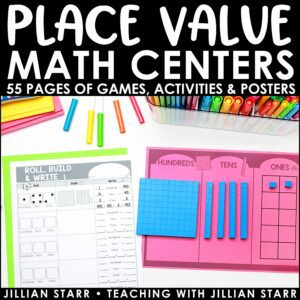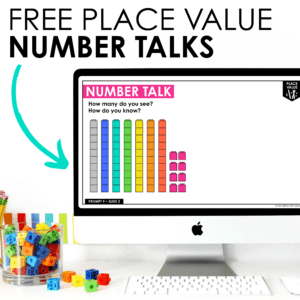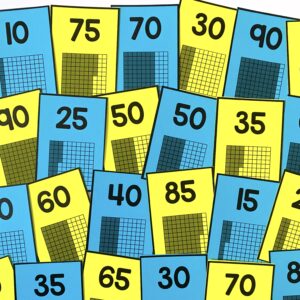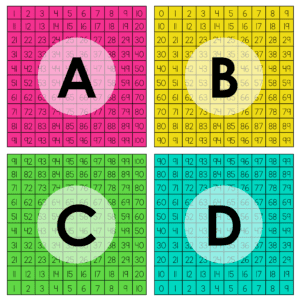
Walk into any first-grade classroom and 99% of the time you will see a hundred chart up on the wall – and for good reason! Regardless of whether you use the 1-100 chart, the 0-99 chart, top to bottom, or bottom to top, the hundred chart is a valuable tool to teach students a variety of place value skills.
This week our place value series continues with adding and subtracting with a hundred chart. Not only is adding and subtracting tens and ones a first-grade Common Core standard, but there is a lot packed into it! In particular, first graders learn to:
- Add a two-digit number and a one-digit number
- Add a two-digit number and a multiple of 10 within 100
- Subtract a multiple of 10 from a number between 10 and 90
- Mentally adding or subtracting 10
That’s a lot! So, how do I get my mathematicians to that point by the end of the year?
Getting Familiar with the Hundred Chart
The first step to having students use the hundred chart to add and subtract tens and ones is to ensure they are familiar with the chart as is. To start, you’ll have to decide which version of the chart you prefer. All versions have benefits and regardless of which one you are using with your students, you want your students to know where it begins, ends, and how to use it to count.

One way I help students become familiar with the chart is to display parts of it and then ask students what they notice and what they wonder. We also use the hundred chart to practice choral counting. The use of both of these routines allows students to investigate the patterns in the hundred chart.
To practice recognizing and creating a place value chart, two of my favorite activities are creating a hundred chart and hundred chart puzzles.
Hundred Chart Puzzles
To bridge the gap between recognizing and creating a hundred chart, I like to use number tiles that students arrange in the hundred chart format. There are Montessori hundred boards that you can purchase, but you don’t have to spend money to get the benefits! Instead, it’s even easier to write out the numbers 0-99 or 1-100 on index cards and then have students spread out to create their own giant chart on the floor.
Once students are comfortable building a hundred chart, it’s time for an all-time student favorite: Hundred Chart Puzzles! Not only are hundred chart puzzles fun and engaging – they are so easy to prep. Just cut along the outside of the chart and then cut on the dark lines and you’ll have a hundred chart puzzle. To make these easier to use from year to year, I recommend printing them on different color card stock so that they can easily be sorted by puzzle.
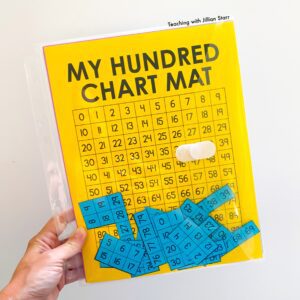
Free Hundred Chart Puzzles & Mats
Help reinforce the structure of the Hundred Chart (and have fun) with these FREE Hundred Chart Puzzles! There are 20 different puzzles for both the 1-100 and 0-99 charts.
These puzzles are great for students to use independently. They are self-correcting on their own, but you can also always provide the hundred chart mat for students to complete their puzzles on or even just to refer to.
Hundred Chart Puzzles can also be used during small groups. Present the group with a puzzle piece and ask them to predict what number will be next to, above, or below one of the numbers on the puzzle piece. Students can even work together to complete the puzzles.
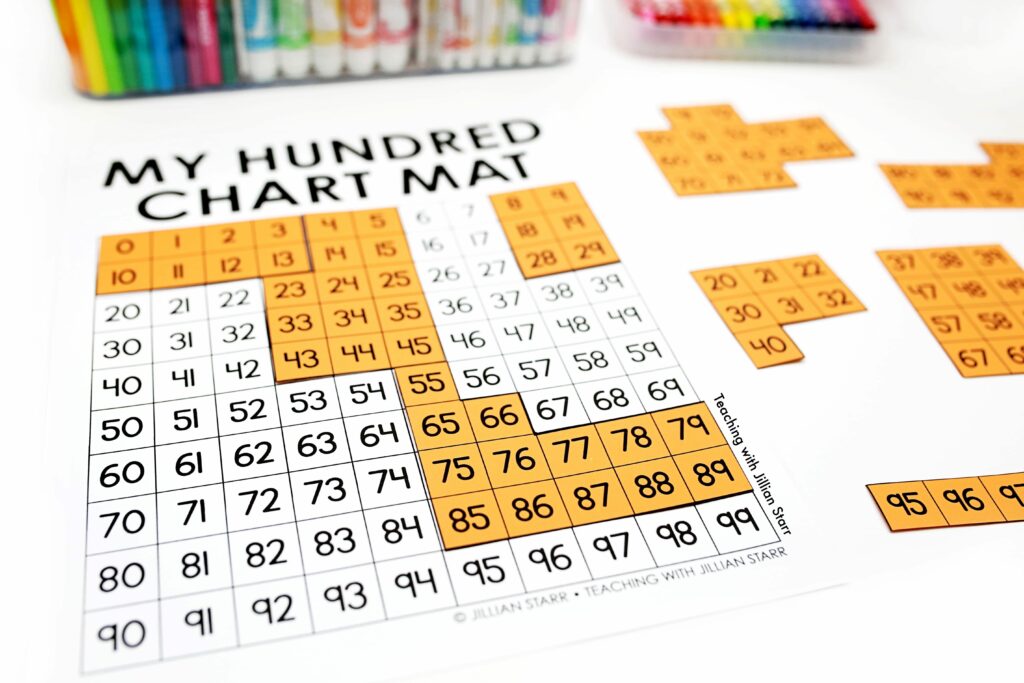

At the same time, students can practice filling in their own blank hundred charts. Creating a hundred chart is different from using a premade chart to count or completing a hundred chart puzzle because students have to generate the numbers themselves rather than just recognizing them. Combining these activities is a great way to help students solidify their familiarity with the chart.
Moving on the Hundred Chart
If you’re familiar with our little corner of the internet, you know how much I love Lesh’s translation model and how important the connection between the models is. That’s no different in this case; I want students to be able to make connections between the models when learning to add and subtract tens and ones. I don’t want them to just learn the patterns and procedures. Instead, I want them to truly understand what it means to move on the place value chart when adding tens and ones.
Connecting Cubes
When I’m beginning to support students in making the connection between concrete models and the hundreds frame, I have found that having students use connecting cubes in stacks of tens and extra ones is a great place to start.
We’ll start by using the cubes alone to make observations about what happens when we add tens or ones to a number. For example, if we add 20 to 35, students first build 35 and then add two stacks of tens. I’ll ask, “What do you notice about our equation 35 + 20 = 55?” If necessary, I’ll guide the discussion toward what has changed when adding two tens (the tens, 3 tens to 5 tens) and what stayed the same (the 5 ones).


Similarly, we’ll add ones to a two-digit number and again, notice what has changed. Since we are not yet working on regrouping, I focus on adding ones that do not require regrouping. That will be something we tackle later, but for now, I want students to understand that when we add tens, we are changing the tens place, and when we add ones, we are changing the ones place. We will eventually work on adding ones and watching what happens when we end up with ten or more ones, but that’s a post for another day!
Connecting the Hundred Chart to Connecting Cubes
Next, we move on to explicitly connecting to the hundred chart. At this point, students are familiar with how to add one using connecting cubes and many students have recognized the connection between adding one and counting up and subtracting one and counting down.
However, it is still important to connect adding and subtracting ones using cubes to the hundred chart. This is important in order to make the connection to counting more explicitly. Similar to before, I’ll have students start with a two-digit number and then add some ones. For example, we might build 32 and then add 1 more. I then ask students to notice where we started on the hundred chart and where we ended.
We repeat these steps a few times continuing to add 1 to that starting number and then repeating it with a new starting number. Students then are able to see what it looks like on the hundred chart when we add 1: we move one box to the right.
When we begin adding tens, I have students build a number, such as 14. Together, we find 14 on the hundred chart. Next, I ask students to add a stack of ten to the 14. Now, I’ll write 14 + 10 on the board and ask students to determine the sum. Once we discover that 14 + 10 = 24, we’ll find 24 on the hundred chart. We’ll repeat this process to find 34.
At this point, I ask students what they noticed about what happened when we added ten to each number. I ask students what they wonder, especially what number they think we’ll land on on the hundred chart if we add another ten.
Connecting the pattern of moving down a row (or up a row if you’re using the bottom-up chart!) when adding ten, allows students to see what is really happening when we move on the hundred chart. They are not just focusing on the procedure of moving up or down on the chart, but they are understanding that we are adding a stack of ten.
We repeat these steps when subtracting ten. Again, students build a number and we subtract a stack of ten one at a time, making note of where we land on the hundreds chart. This way, students are making the connection between the concrete and abstract representations of subtracting ten.
Abstract Addition with the Hundred Chart
As I mentioned earlier, we don’t want students to just follow the procedure for adding and subtracting tens and ones, but we want them to truly understand what is happening. That being said, the hundred chart is a great tool for modeling adding and subtracting tens and ones in a more abstract way.
At this point, if you’ve worked to connect the work with cubes to the hundred chart, students are likely quite familiar with what happens on the chart when we add or subtract 10 – we move up or down a row. Now, students are able to use cubes or the hundred chart when solving problems involving tens and ones.
I often give students the choice of what tool they want to use. Most of the time students will pick the tool that works best for them, but occasionally, I do steer a student toward a tool that they are more successful with.
But we don’t just solve addition and subtraction problems in isolation using the hundred chart! Kids love playing games on the hundred chart too. One of the easiest partner games we play requires just a blank hundred chart and a small token like a counting bear or unit cube.
We set up a folder or privacy shield so that only one partner can see the chart. That partner, player 1, places the token on a number on the chart. Their job is to now give directions to player 2 for how to get from their starting number to the token by adding or subtracting tens or ones. We usually have player 2 choose their starting number randomly and they just let player 1 know where they are starting. A round is over when player 2 is able to say the number where the token is based on player 1’s directions. It’s like a mini game of battleship!
Not only is this game really fun, but students are practicing using the hundred chart to add and subtract tens and ones as well as to take it a step further and create their own equations using the chart.
And that’s it – that’s how I use the hundred chart to teach adding and subtracting ones and tens. Have a strategy or activity you love to use? Share it with us in the comments!

